

GetProcAddress function. Using the Windows Headers. Visual C++ and the Windows Header Files Microsoft Visual C++ includes copies of the Windows header files that were current at the time Visual C++ was released.
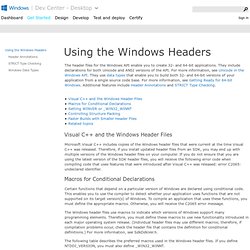
Therefore, if you install updated header files from an SDK, you may end up with multiple versions of the Windows header files on your computer. If you do not ensure that you are using the latest version of the SDK header files, you will receive the following error code when compiling code that uses features that were introduced after Visual C++ was released: error C2065: undeclared identifier. Macros for Conditional Declarations Certain functions that depend on a particular version of Windows are declared using conditional code. The Windows header files use macros to indicate which versions of Windows support many programming elements. The following table describes the preferred macros used in the Windows header files. The following tables describe other macros used in the Windows header files.
Ac_cv_type_ Autoconf - Existing Tests. Go to the first, previous, next, last section, table of contents.

These macros test for particular system features that packages might need or want to use. If you need to test for a kind of feature that none of these macros check for, you can probably do it by calling primitive test macros with appropriate arguments (see section Writing Tests). These tests print messages telling the user which feature they're checking for, and what they find.
AIX commands you should not leave home without. Shiv DuttaPublished on April 04, 2014 As you know, AIX has a vast array of commands that enable you to do a multitude of tasks.

Depending on what you need to accomplish, you use only a certain subset of these commands. These subsets differ from user to user and from need to need. However, there are a few core commands that you commonly use. You need these commands either to answer your own questions or to provide answers to the queries of the support professionals. In this article, I'll discuss some of these core commands. Modman.unixdev.net - Page: pstat_getprocessor(2) in [HP-UX-11.11] HP-UX - how get hardware (server,card,slot) information.
HP-UX - how get hardware (server,card,slot) information. How to get CPU socket and core information? NUMA Frequently Asked Questions. System Descriptions. This section will describe various platforms.

Some of them may exist at this time, while others are fictional and may someday be manufactured. The intent is to show the diversity of potential system topologies. The systems described in this document include: A typical SMP system. The Alpha Wildfire system. The IBM Numa-Q system. A typical SMP system The following diagram shows a typical SMP system design, utilizing Intel x86 processors: Hwloc Tutorials. Tutoriel hwloc @ ComPAS 2013. Non-Uniform Memory Access. Non-uniform memory access (NUMA) is a computer memory design used in multiprocessing, where the memory access time depends on the memory location relative to the processor.
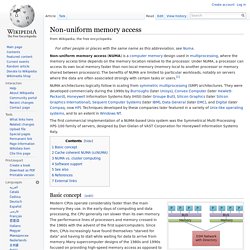
Under NUMA, a processor can access its own local memory faster than non-local memory (memory local to another processor or memory shared between processors). Hwloc: Portable Hardware Locality. Context The democratization of multicore processors and NUMA architectures (AMD HyperTransport, Intel QPI, ...) leads to the spreading of complex hardware topologies into the whole server world.
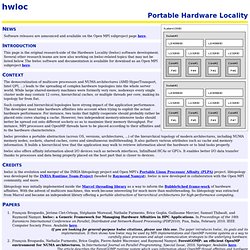
While large shared-memory machines were formerly very rare, nodaways every single cluster node may contain 12 cores, hierarchical caches, or multiple threads per core, making its topology far from flat. Such complex and hierarchical topologies have strong impact of the application performance. The developer must take hardware affinities into account when trying to exploit the actual hardware performance. For instance, two tasks that tightly cooperate should probably rather be placed onto cores sharing a cache. Hwloc provides a portable abstraction (across OS, versions, architectures, ...) of the hierarchical topology of modern architectures, including NUMA memory nodes, sockets, shared caches, cores and simultaneous multithreading.
BlueBrain/hwloc. Hwloc-v1.1.1-letter.pdf. Strange cpuinfo, how many cores does these physical cpu has. Portable Hardware Locality (hwloc) The Portable Hardware Locality (hwloc) software package provides a portable abstraction (across OS, versions, architectures, ...) of the hierarchical topology of modern architectures, including NUMA memory nodes, sockets, shared caches, cores and simultaneous multithreading.
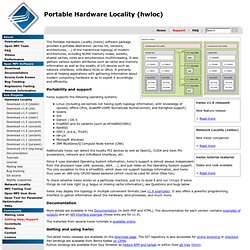
It also gathers various system attributes such as cache and memory information as well as the locality of I/O devices such as network interfaces, InfiniBand HCAs or GPUs. It primarily aims at helping applications with gathering information about modern computing hardware so as to exploit it accordingly and efficiently. Portability and support hwloc supports the following operating systems: Portable Hardware Locality (hwloc) Portable Hardware Locality (hwloc) Documentation: v1.7.1. Hwloc provides command line tools and a C API to obtain the hierarchical map of key computing elements, such as: NUMA memory nodes, shared caches, processor sockets, processor cores, processing units (logical processors or "threads") and even I/O devices. hwloc also gathers various attributes such as cache and memory information, and is portable across a variety of different operating systems and platforms.
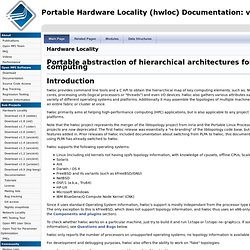
Additionally it may assemble the topologies of multiple machines into a single one so as to let applications consult the topology of an entire fabric or cluster at once. hwloc primarily aims at helping high-performance computing (HPC) applications, but is also applicable to any project seeking to exploit code and/or data locality on modern computing platforms. Note that the hwloc project represents the merger of the libtopology project from inria and the Portable Linux Processor Affinity (PLPA) sub-project from Open MPI.
Both of these prior projects are now deprecated. Shell$ . . c02267025.pdf. SYSTEM_INFO structure. Contains information about the current computer system.
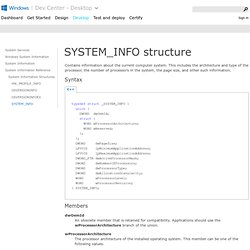
This includes the architecture and type of the processor, the number of processors in the system, the page size, and other such information. Syntax. UX Software Transition Kit. Pstat - pstat() functional interface changes (NcWn726) Problem description The pstat system call has been modified so that pstat_getdynamic() accounts for the new instant activation of additional processors without needing to reboot the system.

Get_nprocs_conf(3) - Linux manual page. Linux: Find Number of CPU Cores Command. How do I find out the number of CPU cores available under HP x86_64 Linux serer running on RHEL / Debian Linux 6.x? You can use the lscpu or nproc command to display the number of processing units available to the current process, which may be less than the number of online processors (please note that not all server supports hotplug a CPU on a running Linux system). The proc file system is a pseudo-file system which is used as an interface to kernel data structures. It is commonly mounted at /proc. C++ - Programmatically find the number of cores on a machine. Ia64. Processor topology information is important for a number of processor-resource management practices, ranging from task/thread scheduling, licensing policy enforcement, affinity control/migration, etc.
Topology information of the cache hierarchy can be important to optimizing software performance. This white paper covers topology enumeration algorithm for single-socket to multiple-socket platforms using Intel 64 and IA-32 processors. Aix machine - licensing. AIX > Administrator > LPAR Use the lparstat command to obtain an accurate understanding of LPAR processing resources For AIX-based Power Systems servers, many software vendors base their licensing on processor core counts. With the many configuration options available under PowerVM, it’s become a challenge to track the number of processor cores that a particular LPAR can access.
This article will show you how the AIX lparstat command can determine the number of cores each LPAR can access. The number of LPARs running a particular software package and the shared processor pool configuration also come into play when determining how many total cores to license. Running lparstat. AIX OS. AIX machine. AIX machine. Hi shawshank, I don't mean to bang on but I think baznz is correct and there is simply a terminoligy problem here. power5 processors only come in 2 way and 4 way modules. Windows, Mac or Linux.